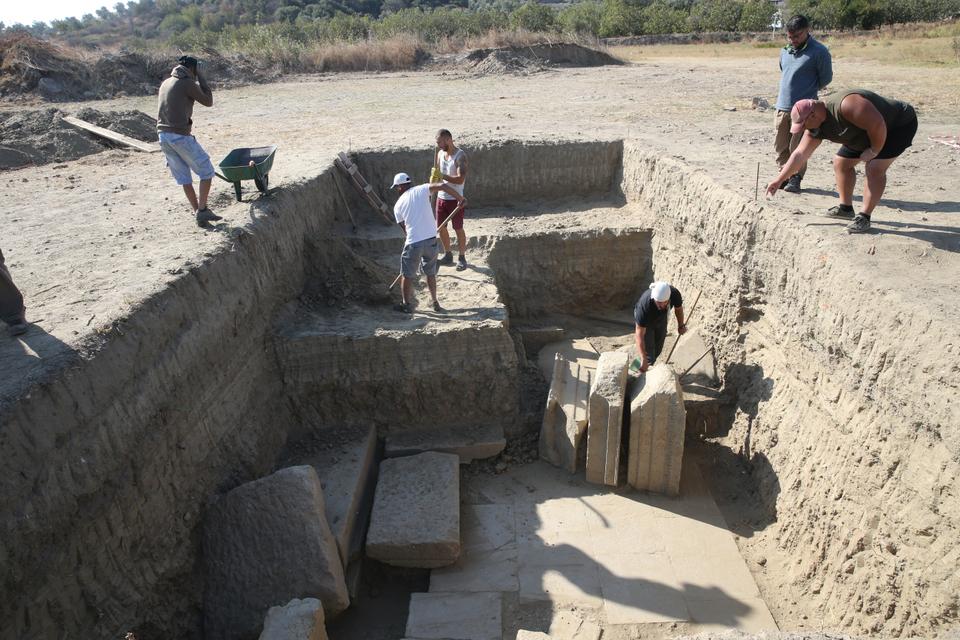Though having passed the site of Magnesia ad Maeandrum (Magnesia on the Meander) on innumerable occasions I must guiltily admit that time always seemed to allude me, writes Glenn Maffia.. The constant promise of “next time” just never materialised. To be honest, from the road the site looks less than inspiring, just sturdy city walls and the odd jutting column peeking over the parapet.
A light in the bleakness
All that idle apathy was promptly swept aside when I read of a ‘new’ archaeological find a couple of weeks ago. The Turkish Archaeological team, whom had reported the news, had excavated a temple said to be dedicated to the god Zeus. Naturally, this was music to my ears and I was soon searching through the weather forecasts to find a window without expected rain. I messaged two friends equally interested in the history of this land, and a provisional date was set.
Fortunately, the weather people were near accurate when the day arrived, so off we set.

Upon entering the car park the vista continued to appear less than inspiring. A single rather drab looking one-storied building greeted us, the last door of which transpired to be the ticket office. The entrance official seemed to be quite overjoyed to see someone, though I guess this must be a most solitary profession in the blackening months of early winter (the tourists depart when the sun dims in a cloud ridden sky).
I always ask to buy a guidebook whenever visiting a new (to me) site, just to give me a brief overview of what to expect and refer to anything which I find incomprehensible, there wasn’t one. Possibly there are in the summer months, I don’t know. Though he did hand me a leaflet of a simple schematic map upon its reverse side; it was something to work with, and I guessed that would be it.

It took me about 30 seconds, when approaching the first impressive monument, to have to take all my reticence straight back, for there was a fully comprehensive information board. Each ancient structure was accompanied by a fully detailed textual and illustrated description, in Turkish, English and German. It was as surprising as it were interesting. I immediately fell passionately in love with the site.
But we were here to view the ‘newly’ excavated Temple of Zeus.
Objective located
Though the temple is mentioned in the notes upon the schematic map it frustratingly is not geographically indicated. But worry not; my friends and I are more than capable of solving little problems of that kind. It really isn’t that difficult.
We conjectured, going by the leaflets numbering system of prominent structures that the temple would be close to the Sacred Agora. No sooner had we reached the unexcavated high ground surrounding this agora than we saw the telltale signs of excavated mounds of earth. Objective located.

Plastic coverings were draped down over the sides of the trench, protecting the mud walls from slipping inwards during this rainy season, though the base of the trench was home to the vast array of fallen fluted column segments and what appear to be pieces of fragmented architrave resting upon the most exquisite marble flooring. I found myself immediately being transported back in time to approximately 2,200 or more years ago. That is always a euphoric feeling.
Though something was nagging me about this site; it looked haphazard, not in a natural time-worn decay and the architectural fragments appeared rather uniform in their shape and size. I rather thought that I would, once more, conduct a bit of ‘online digging’.
Online digging pays dividends
The present day excavation is being undertaken by Associate Professor Gorkem Kokdemir from Ankara University who has been working on the Magnesia site since 1998. Therefore, no doubt, we have him to thank for those excellent information boards. He dates the Temple of Zeus to the 3rd century BCE, much later than the Temple of Artemis at Ephesus and the Temple of Apollo at Didyma, though still a comparatively early example of a Hellenistic temple within Anatolia.
Professor Kokdemir also gives some insightful historical information into the initial excavations.
A German archaeologist by the name of Carl Humann became very active in the ancient cities of western Anatolia during the final years of the 19th century. It was he who was the initial person to excavate Magnesia ad Maeandrum between 1891 and 1892 where he rediscovered the Temple of Zeus.
Much of what Humann found was reinterred upon the completion of this particular site, though not before shipping a good proportion, some 10% of the temple, back to Germany. This portion of the structure continues to reside and be displayed in the Pergamon Museum back in Berlin. What is more, Humann additionally removed many sculptures and inscriptions of the temple.

Evidently, visitors to the Pergamon today, can not only be impressed with those artefacts but can also be astonished at the reconstruction of a part of Zeus’ temple which stands at an impressive 5.5 – 6 metres in height (18+ feet).
After the slow but inevitable demise of the ancient pagan places of worship after the Christian instigation of Emperor Theodosius I much of the glorious marble buildings fell prey to the Lime Burners.
If one burns marble it produces lime which was a crucial ingredient in the production of mortar, an important and profitable industry. Other marble building blocks were reused to fashion churches.
Here as I write in ancient Didyma, Apollo’s temple standing so proud today only survives as it was most fortuitously buried in the natural hollow it resides within.
We did not have the time to visit the entire archaeological site on this occasion, as the dark low-hanging clouds threatened a deluge, though we agreed that further visits most certainly will be on an imminent agenda.
